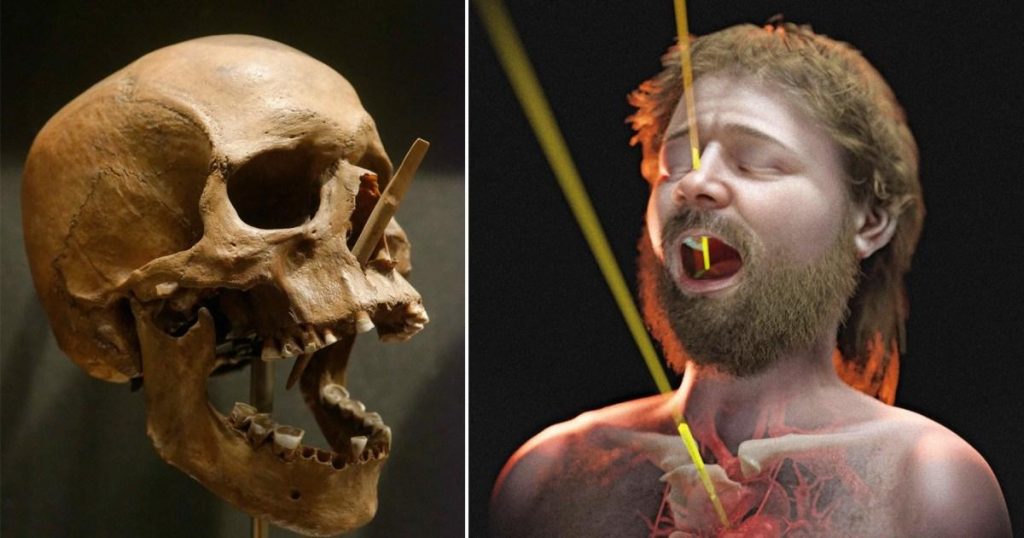Unveiling the Face of the Porsmose Man: A Forensic Reconstruction of a Bronze Age Death
In 1946, within the murky depths of a Danish peat bog near Næstved, a remarkable discovery emerged – the well-preserved remains of a man from the Bronze Age, subsequently named the Porsmose Man. This individual, who lived over 5,000 years ago, met a violent end, evidenced by the presence of arrowheads lodged in his face and chest. While his remains offered a glimpse into a distant past, his facial features remained shrouded in mystery until recently. A team of researchers, led by Cicero Moraes, embarked on a groundbreaking project to reconstruct the Porsmose Man’s face, not merely to reveal his likeness in life, but to capture the very moment of his death, a unique undertaking in forensic facial reconstruction.
Traditionally, forensic facial reconstruction aims to recreate the living faces of deceased individuals based on their skeletal remains. Moraes and his team, however, ventured beyond this conventional approach. Their objective was not solely to rebuild the Porsmose Man’s face as it appeared in life, but to visualize the injuries inflicted upon him, specifically the arrow wounds that marked his demise. The striking arrow embedded in his face, while visually arresting, was not the fatal blow. Through meticulous analysis, the researchers determined that the arrow piercing his chest was the true cause of death, severing vital blood vessels and leading to rapid expiration. This reconstruction, therefore, captures not just a face, but a narrative of a violent end in the Bronze Age.
The reconstruction process involved a meticulous digital recreation of the Porsmose Man’s skeletal structure, utilizing photographs and precise measurements. This digital skeleton served as the foundation upon which Moraes, a graphics expert, and his team meticulously rebuilt the facial features using established forensic techniques. They crafted a bust that incorporated the arrow wounds, allowing a visualization of the injuries sustained. To further understand the fatal blow, they reconstructed the chest area, including bones and the circulatory system, tracing the path of the deadly arrow and its devastating impact on vital organs. This process revealed the trajectory of the bone-tipped arrow, which likely pierced the brachiocephalic vein, aortic arch, and right pulmonary vein, causing a swift and fatal hemorrhage.
The reconstruction revealed the face of a man aged between 35 and 40 years old at the time of his death, standing approximately 5’4" tall. While the exact circumstances surrounding his death remain shrouded in mystery, the presence of the arrow wounds suggests a violent end, possibly related to conflict or execution. After being struck by the arrows, his body was either submerged in the bog or fell into the water, where the unique environment preserved his remains for millennia. The National Museum of Denmark, where the Porsmose Man’s remains are housed, has offered a speculative narrative, portraying him as a farmer murdered during a violent home invasion. This narrative, while imaginative, emphasizes the inherent violence of his demise.
The story envisioned by the museum paints a picture of a brutal attack: Intruders silently infiltrate a sleeping household, clubbing the guard dogs into submission. They set fire to the thatched roofs, plunging the home into chaos. The Porsmose Man, awakened by the commotion, grabs his axe and leads his family to escape the burning dwelling. Amidst the pandemonium, he loses sight of his children and witnesses one of the attackers abducting his wife. In a desperate attempt to rescue her, he pursues the assailant, axe raised, only to be felled by a searing pain in his chest. A second arrow strikes his face as darkness descends, ending his life. While captivating, this narrative remains purely speculative, a fictionalized account based on the limited evidence available.
The forensic facial reconstruction of the Porsmose Man offers a unique glimpse into the life and death of an individual from the Bronze Age. It moves beyond traditional reconstruction techniques, capturing not only the likeness of the deceased but also the very moment of his violent demise. The image of the arrow lodged in his face, while dramatic, belies the true cause of death, a fatal arrow wound to the chest. This reconstruction underscores the power of forensic science to unveil the secrets of the past, offering a tangible connection to a human life extinguished over 5,000 years ago. While the precise circumstances surrounding his death remain a mystery, the Porsmose Man’s reconstructed face serves as a poignant reminder of the violence that punctuated prehistoric life, as well as the remarkable ability of science to bring the distant past into sharp focus.


